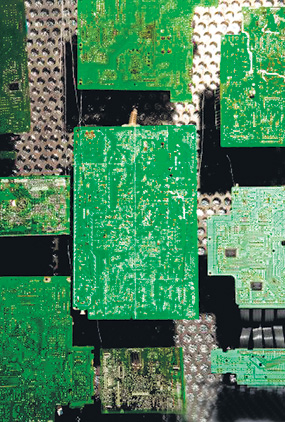
VirtualisationThe first telephone answering machines were bulky unwieldy devices. They recorded the messages on magnetic tapes that required frequent rewinding and replacing, but it wasn't long before they were replaced with digital answering machines that recorded messages as 'bits,' allowing them to be manipulated by all sorts of new features that could be added to the machine as 'software.' You could skip messages, delete them or filter them according to their source instantly. However, once the device became digital, it didn't have to be a device anymore, so it turned into a service running purely as code out in the telephone company's network as with mobile phones today. And so we have virtually thrown out the answering machine and subscribed to a service instead. The physical device has vaporized into the "cloud" of the network. If you think about it long, hard and deep, your computer is just a much more elaborate version of the telephone answering machine. With the advent of ever faster networks that are more reliable and more efficient, it too can now be encapsulated into software and transferred into a network cloud. This is the essence of what is known as 'virtualisation.'
Virtualisation is about hiding the physical properties of hardware from the user. It is a broad concept because it may mean making multiple physical devices seem as one logical device to the user, of making a single physical device seem like multiple devices offering different services and applications to many users at the same time. Virtualisation software such as offerings from VMware makes it possible to run multiple operating systems and/or multiple instances of the same operating system on the same physical device, to be used by multiple users. This has been made practically viable by the ever increasing speed of hardware which is now powerful enough to perform well under heavy loads on their processors. Companies like HP and IBM have long since consolidated multiple Data Centre servers into giant remotely managed server farms, cutting down on their service and maintenance costs, including hardware, multiple software licenses and labour costs. And when you follow the logic of virtualization and consolidation to its conclusion, at some point, will all the computing power in the world be consolidated in one place? Of course not, but that is totally missing the point. The logical outcome of virtualisation is to make the geographically dispersed computer resources of the world to 'seem' as one entity. The private data centre should follow the private answering machine into the cloud. Private infrastructure should turn into a shared utility, but will it really happen? Google CEO Eric Schmidt answered the question best when he said, "When the network becomes as fast as the processor, the computer hollows out and spreads across the network." So will it be goodbye "World Wide Web, hello "World Wide Computer?" Well…since we are talking about technology, I will dare not try to make any predictions! But don't hesitate to write in to technopage@gmail.com and make yours. Improve your computer literacy LDAP Short for Lightweight Directory Access Protocol, LDAP is a set of protocols for accessing information directories. LDAP is based on the standards contained within the X.500 standard, but is significantly simpler. And unlike X.500, LDAP supports TCP/IP, which is necessary for any type of Internet access. Because it's a simpler version of X.500, LDAP is sometimes called X.500-lite. Although not yet widely implemented, LDAP should eventually make it possible for almost any application running on virtually any computer platform to obtain directory information, such as email addresses and public keys. Because LDAP is an open protocol, applications need not worry about the type of server hosting the directory. –Webopedia.com Bits and bytes Mobile Alert The U.S. Federal Communications Commission has moved to set up a system that would send text alerts to people on their mobile phones in case of natural disasters and other emergencies. The adopted technical requirements for transmission of the alerts would require the cooperation of mobile operators. The Commercial Mobile Alert System (CMAS) will be designed to reach more than 250 million people in the United States that have mobile phones today. The system would send out three types of alerts: Imminent Threat Alerts, with information on emergencies that may pose an imminent threat to peoples' lives or well-being, Child Abduction Emergency/AMBER Alerts concerning missing children and Presidential Alerts, which would override any other pending alerts. The alerts initially would be text only with vibration and audio signals for people with disabilities but they plan to include audio and video content in the future. – PCWorld MS on the road Microsoft want's to pull people out of traffic jams! With the introduction of Clearflow technology to its Live.com site Microsoft is engaged in an ambitious effort to add AI machine-learning techniques to the complex problem of predicting traffic congestion. A pile-up on a highway, for example, often sends cars spilling into surface streets to avoid the mess, tying them up as badly as the original jam. It's often faster to stay on the highway, rather than detour. But how would you know this? Clearflow makes predictions about these types of scenarios. The technology is aimed squarely at traffic reporting utilities from Google, Yahoo and MapQuest, among others. It is integrated into the driving directions that Microsoft introduced last year. It's a very complex system that uses algorithms to model hundreds of thousands of road segments. |
|
||||||
|| Front
Page | News | Editorial | Columns | Sports | Plus | Financial
Times | International | Mirror | TV
Times | Funday
Times || |
| |
Reproduction of articles permitted when used without any alterations to contents and a link to the source page.
|
© Copyright
2008 | Wijeya
Newspapers Ltd.Colombo. Sri Lanka. All Rights Reserved. |
